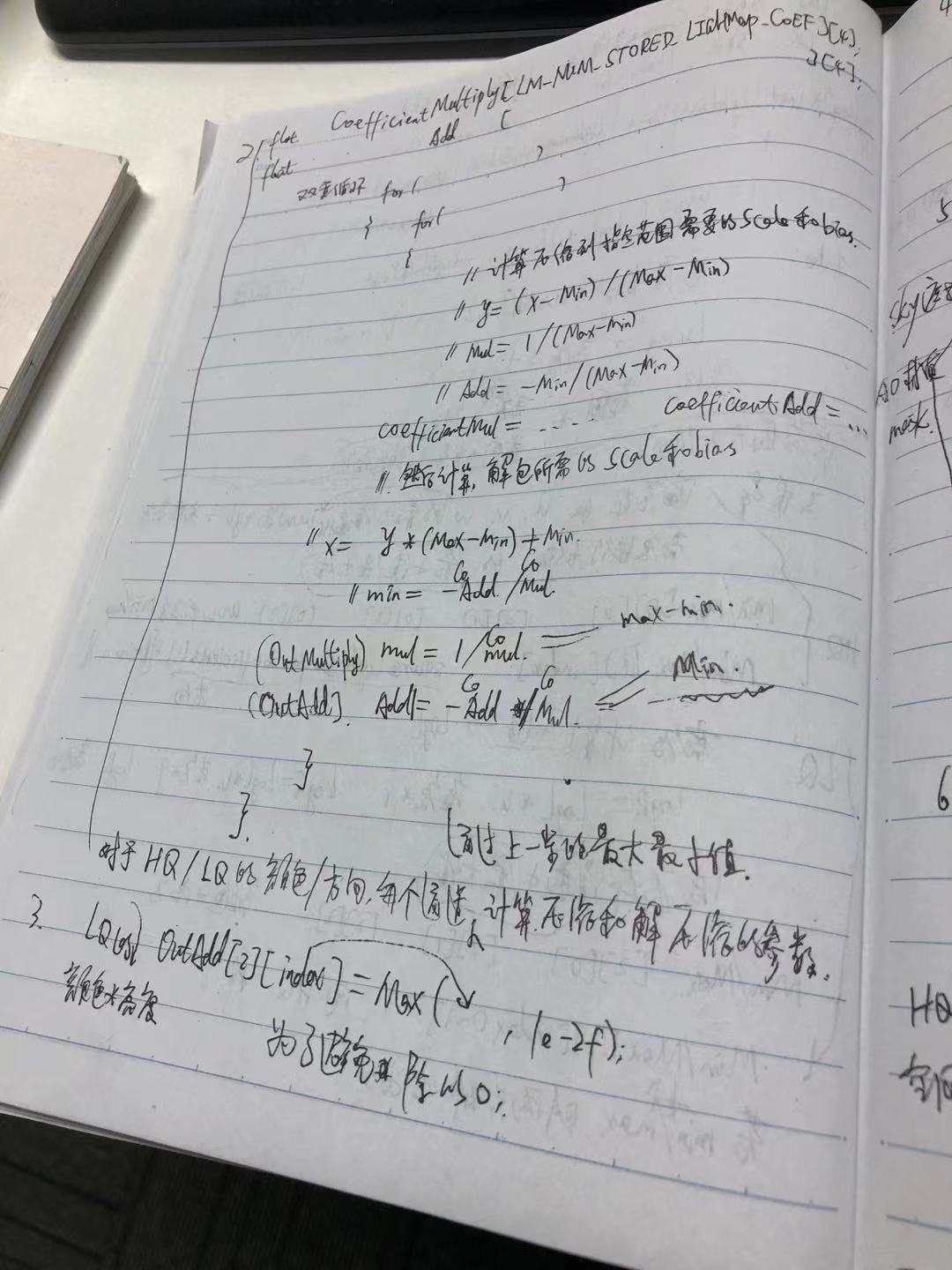ue4 lightmap格式解析
2021-02-23 14:05 kk20161206 阅读(722) 评论(0) 编辑 收藏 举报lightmass分hq(pc和主机平台)和lq(移动平台),两者都存照明颜色、照明亮度、入射光线的簇的最大贡献方向。
一、 ue4光照图
1. lq分上下两部分,上部分是(光线颜色的线性空间值*照明亮度经log函数处理值)的归一化值,下半部分是入射光线的簇的最大贡献方向的归一化的值。采用24为rgb8的格式存储,默认会根据平台相关的压缩方式进行压缩以减小内存占用、存储空间、渲染时占用的gpu带宽。
2. hq也分上下两部分,但上半部分存的是(归一化后的照明颜色)的gamma空间值,和亮度log函数处理的值的整数部分再归一化的值(A通道);下半部分存入射光线的簇的最大贡献方向值的归一化的值,和亮度log函数处理的值的小数部分的归一化值(A通道)。所以多一个通道,用rgb32存储,会用平台相关的压缩方式进行压缩,但压缩后还是比lq的大接近一倍。
二、 光照图编码方式
由于光照亮度的亮度范围应该是浮点数区间,所以最好的存储模式是浮点数格式,即exr,但是其存储、内存占用、带宽更大,同时有平台兼容性问题,所以各引擎一般在移动端用rgb8或rgba8图。
把亮度从浮点数压缩到0-255的整数范围会造成精度的丢失,造成光照图质量降低。
ue4用自己开发的编码分别对lq和hq进行编码压缩。
1. lq亮度编码
LQ亮度压缩的量化函数(函数1):

y表示编码后的亮度,值域为 y∈[0,1]
常数0.00390625为最小亮度
函数图示:

x取值范围是0-255,y取值范围是0-1。看图,x从0-1的过程中,y从0变到了0.5,可以看出占总定义域的1/255的x取值占了%50的值域。这说明,ue4 做了取舍,把更多的精度给了暗部,而损失了部分亮部的精度。由于lightmap烘焙的都是间接光亮度,所以这有一定的合理性。x的取值范围是0-255,实际却用不了这么多,所以后面会进行归一化处理,即将该函数结果乘亮度的结果进行归一化。
2. hq亮度编码

上式中y表示编码后的亮度,取值域为 y∈[0,1]
常数0.01858136为最小亮度
函数图示如下:
观察该函数的曲线知道,和LQ一样,为暗部保留更多的细节。
x为1时,y为0;x为2-0.01858时,y为1.
所以,也会对该log函数的结果进行归一化,保证亮度范围的变化性和精度的高利用率。
三、 整个过程
1. 


遍历各个sample,
hq获得uvw和亮度的log值的min、max值;方向*亮度的值的最大最小值。
static void GetLUVW( const float RGB[3], float& L, float& U, float& V, float& W )
{
float R = FMath::Max( 0.0f, RGB[0] );
float G = FMath::Max( 0.0f, RGB[1] );
float B = FMath::Max( 0.0f, RGB[2] );
L = 0.3f * R + 0.59f * G + 0.11f * B;
if( L < 1e-4f )
{
U = 1.0f;
V = 1.0f;
W = 1.0f;
}
else
{
U = R / L;
V = G / L;
W = B / L;
}
}
{
// Complex
float L, U, V, W;
GetLUVW( SourceSample.Coefficients[0], L, U, V, W );
float LogL = FMath::Log2( L + LogBlackPoint );
MinCoefficient[0][0] = FMath::Min( MinCoefficient[0][0], U );
MaxCoefficient[0][0] = FMath::Max( MaxCoefficient[0][0], U );
MinCoefficient[0][1] = FMath::Min( MinCoefficient[0][1], V );
MaxCoefficient[0][1] = FMath::Max( MaxCoefficient[0][1], V );
MinCoefficient[0][2] = FMath::Min( MinCoefficient[0][2], W );
MaxCoefficient[0][2] = FMath::Max( MaxCoefficient[0][2], W );
MinCoefficient[0][3] = FMath::Min( MinCoefficient[0][3], LogL );
MaxCoefficient[0][3] = FMath::Max( MaxCoefficient[0][3], LogL );
// Dampen dark texel's contribution on the directionality min and max 抑制暗处的方向最大最小值的贡献
float DampenDirectionality = FMath::Clamp(L * 100, 0.0f, 1.0f);
for( int32 ColorIndex = 0; ColorIndex < 3; ColorIndex++ )
{
MinCoefficient[1][ColorIndex] = FMath::Min( MinCoefficient[1][ColorIndex], DampenDirectionality * SourceSample.Coefficients[1][ColorIndex] );
MaxCoefficient[1][ColorIndex] = FMath::Max( MaxCoefficient[1][ColorIndex], DampenDirectionality * SourceSample.Coefficients[1][ColorIndex] );
}
}
lq获得u*亮度的log值的min、max,v*亮度的log值的min、max,w*亮度的log值的min、max值;方向*亮度的值的min、max值。
{
// Simple
float L, U, V, W;
GetLUVW( SourceSample.Coefficients[2], L, U, V, W );
float LogL = FMath::Log2( L + SimpleLogBlackPoint ) / SimpleLogScale + 0.5f;
float LogR = LogL * U;
float LogG = LogL * V;
float LogB = LogL * W;
MinCoefficient[2][0] = FMath::Min( MinCoefficient[2][0], LogR );
MaxCoefficient[2][0] = FMath::Max( MaxCoefficient[2][0], LogR );
MinCoefficient[2][1] = FMath::Min( MinCoefficient[2][1], LogG );
MaxCoefficient[2][1] = FMath::Max( MaxCoefficient[2][1], LogG );
MinCoefficient[2][2] = FMath::Min( MinCoefficient[2][2], LogB );
MaxCoefficient[2][2] = FMath::Max( MaxCoefficient[2][2], LogB );
// Dampen dark texel's contribution on the directionality min and max 抑制暗处的方向最大最小值的贡献
float DampenDirectionality = FMath::Clamp(L * 100, 0.0f, 1.0f); for( int32 ColorIndex = 0; ColorIndex < 3; ColorIndex++ ) { MinCoefficient[3][ColorIndex] = FMath::Min( MinCoefficient[3][ColorIndex], DampenDirectionality * SourceSample.Coefficients[3][ColorIndex] ); MaxCoefficient[3][ColorIndex] = FMath::Max( MaxCoefficient[3][ColorIndex], DampenDirectionality * SourceSample.Coefficients[3][ColorIndex] ); } }
2. 根据求得的max和min,获得归一化函数的scale和add值。y = kx+b的k和b值以及反向从y计算x的k和b值,为了压缩和解压缩:

// Calculate the scale/bias for the light-map coefficients.
float CoefficientMultiply[LM_NUM_STORED_LIGHTMAP_COEF][4];
float CoefficientAdd[LM_NUM_STORED_LIGHTMAP_COEF][4];
for (int32 CoefficientIndex = 0; CoefficientIndex < LM_NUM_STORED_LIGHTMAP_COEF; CoefficientIndex++)
{
for (int32 ColorIndex = 0; ColorIndex < 4; ColorIndex++)
{
// Calculate scale and bias factors to pack into the desired range
// y = (x - Min) / (Max - Min)
// Mul = 1 / (Max - Min)
// Add = -Min / (Max - Min)
CoefficientMultiply[CoefficientIndex][ColorIndex] = 1.0f / FMath::Max<float>(MaxCoefficient[CoefficientIndex][ColorIndex] - MinCoefficient[CoefficientIndex][ColorIndex], DELTA);
CoefficientAdd[CoefficientIndex][ColorIndex] = -MinCoefficient[CoefficientIndex][ColorIndex] / FMath::Max<float>(MaxCoefficient[CoefficientIndex][ColorIndex] - MinCoefficient[CoefficientIndex][ColorIndex], DELTA);
// Output the values used to undo this packing
OutMultiply[CoefficientIndex][ColorIndex] = 1.0f / CoefficientMultiply[CoefficientIndex][ColorIndex];
OutAdd[CoefficientIndex][ColorIndex] = -CoefficientAdd[CoefficientIndex][ColorIndex] / CoefficientMultiply[CoefficientIndex][ColorIndex];
}
}
3. lq的rgb需要大于0,防止除以0:
4. 方向的反向的a通道的scale和Add值固定,为什么?这俩是sh相关的东西?

5. 分配输出的压缩过的数据的数组,并设置其skyocclusion和aomaterialMask:

const FLightSample& SourceSample = InLightSamples[SampleIndex];
FQuantizedLightSampleData& DestCoefficients = OutLightSamples[SampleIndex];
#if ALLOW_LIGHTMAP_SAMPLE_DEBUGGING
if (SampleIndex == DebugSampleIndex)
{
int32 TempBreak = 0;
}
#endif
DestCoefficients.Coverage = SourceSample.bIsMapped ? 255 : 0;
const FVector BentNormal(SourceSample.SkyOcclusion[0], SourceSample.SkyOcclusion[1], SourceSample.SkyOcclusion[2]);
const float BentNormalLength = BentNormal.Size();
const FVector NormalizedBentNormal = BentNormal.GetSafeNormal() * FVector(.5f) + FVector(.5f);
DestCoefficients.SkyOcclusion[0] = (uint8)FMath::Clamp<int32>( FMath::RoundToInt( NormalizedBentNormal[0] * 255.0f ), 0, 255 );
DestCoefficients.SkyOcclusion[1] = (uint8)FMath::Clamp<int32>( FMath::RoundToInt( NormalizedBentNormal[1] * 255.0f ), 0, 255 );
DestCoefficients.SkyOcclusion[2] = (uint8)FMath::Clamp<int32>( FMath::RoundToInt( NormalizedBentNormal[2] * 255.0f ), 0, 255 );
// Sqrt on length to allocate more precision near 0
DestCoefficients.SkyOcclusion[3] = (uint8)FMath::Clamp<int32>( FMath::RoundToInt( FMath::Sqrt(BentNormalLength) * 255.0f ), 0, 255 );
// Sqrt to allocate more precision near 0
DestCoefficients.AOMaterialMask = (uint8)FMath::Clamp<int32>( FMath::RoundToInt( FMath::Sqrt(SourceSample.AOMaterialMask) * 255.0f ), 0, 255 );
6.利用求出的scale和add归一化。归一化过程,hq的uvw归一化后转换到gamma空间再缩到0-255,l的log的函数的归一化后的整数部分再乘以255存到a,小数部分再乘255存到方向的a,方向的归一化存到方向图中。

{
float L, U, V, W;
GetLUVW( SourceSample.Coefficients[0], L, U, V, W );
// LogLUVW encode color
float LogL = FMath::Log2( L + LogBlackPoint );
U = U * CoefficientMultiply[0][0] + CoefficientAdd[0][0];
V = V * CoefficientMultiply[0][1] + CoefficientAdd[0][1];
W = W * CoefficientMultiply[0][2] + CoefficientAdd[0][2];
LogL = LogL * CoefficientMultiply[0][3] + CoefficientAdd[0][3];
float Residual = LogL * 255.0f - FMath::RoundToFloat( LogL * 255.0f ) + 0.5f;
// U, V, W, LogL
// UVW stored in gamma space
DestCoefficients.Coefficients[0][0] = (uint8)FMath::Clamp<int32>( FMath::RoundToInt( FMath::Pow( U, 1.0f / 2.2f ) * 255.0f ), 0, 255 );
DestCoefficients.Coefficients[0][1] = (uint8)FMath::Clamp<int32>( FMath::RoundToInt( FMath::Pow( V, 1.0f / 2.2f ) * 255.0f ), 0, 255 );
DestCoefficients.Coefficients[0][2] = (uint8)FMath::Clamp<int32>( FMath::RoundToInt( FMath::Pow( W, 1.0f / 2.2f ) * 255.0f ), 0, 255 );
DestCoefficients.Coefficients[0][3] = (uint8)FMath::Clamp<int32>( FMath::RoundToInt( LogL * 255.0f ), 0, 255 );
float Dx = SourceSample.Coefficients[1][0] * CoefficientMultiply[1][0] + CoefficientAdd[1][0];
float Dy = SourceSample.Coefficients[1][1] * CoefficientMultiply[1][1] + CoefficientAdd[1][1];
float Dz = SourceSample.Coefficients[1][2] * CoefficientMultiply[1][2] + CoefficientAdd[1][2];
// Dx, Dy, Dz, Residual
DestCoefficients.Coefficients[1][0] = (uint8)FMath::Clamp<int32>( FMath::RoundToInt( Dx * 255.0f ), 0, 255 );
DestCoefficients.Coefficients[1][1] = (uint8)FMath::Clamp<int32>( FMath::RoundToInt( Dy * 255.0f ), 0, 255 );
DestCoefficients.Coefficients[1][2] = (uint8)FMath::Clamp<int32>( FMath::RoundToInt( Dz * 255.0f ), 0, 255 );
DestCoefficients.Coefficients[1][3] = (uint8)FMath::Clamp<int32>( FMath::RoundToInt( Residual * 255.0f ), 0, 255 );
}
7. lq:l的log函数*颜色归一化,方向也归一化,方向一开始进行了l的抑制,是否会影响?:

{
float L, U, V, W;
GetLUVW( SourceSample.Coefficients[2], L, U, V, W );
// LogRGB encode color
float LogL = FMath::Log2( L + SimpleLogBlackPoint ) / SimpleLogScale + 0.5f;
float LogR = LogL * U * CoefficientMultiply[2][0] + CoefficientAdd[2][0];
float LogG = LogL * V * CoefficientMultiply[2][1] + CoefficientAdd[2][1];
float LogB = LogL * W * CoefficientMultiply[2][2] + CoefficientAdd[2][2];
// LogR, LogG, LogB
DestCoefficients.Coefficients[2][0] = (uint8)FMath::Clamp<int32>( FMath::RoundToInt( LogR * 255.0f ), 0, 255 );
DestCoefficients.Coefficients[2][1] = (uint8)FMath::Clamp<int32>( FMath::RoundToInt( LogG * 255.0f ), 0, 255 );
DestCoefficients.Coefficients[2][2] = (uint8)FMath::Clamp<int32>( FMath::RoundToInt( LogB * 255.0f ), 0, 255 );
DestCoefficients.Coefficients[2][3] = 255;
float Dx = SourceSample.Coefficients[3][0] * CoefficientMultiply[3][0] + CoefficientAdd[3][0];
float Dy = SourceSample.Coefficients[3][1] * CoefficientMultiply[3][1] + CoefficientAdd[3][1];
float Dz = SourceSample.Coefficients[3][2] * CoefficientMultiply[3][2] + CoefficientAdd[3][2];
// Dx, Dy, Dz
DestCoefficients.Coefficients[3][0] = (uint8)FMath::Clamp<int32>( FMath::RoundToInt( Dx * 255.0f ), 0, 255 );
DestCoefficients.Coefficients[3][1] = (uint8)FMath::Clamp<int32>( FMath::RoundToInt( Dy * 255.0f ), 0, 255 );
DestCoefficients.Coefficients[3][2] = (uint8)FMath::Clamp<int32>( FMath::RoundToInt( Dz * 255.0f ), 0, 255 );
DestCoefficients.Coefficients[3][3] = 255;
}
参考文档:https://zhuanlan.zhihu.com/p/68754084



